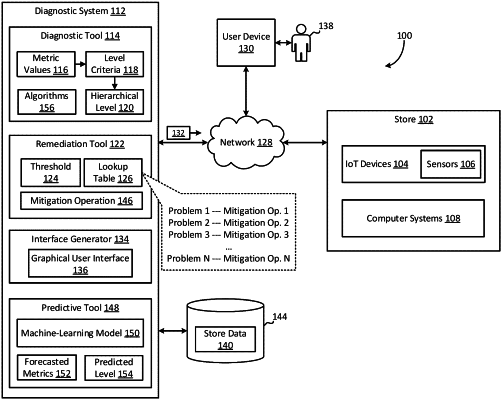| CPC G06Q 10/06393 (2013.01) [G06N 20/00 (2019.01); G06Q 10/20 (2013.01)] | 20 Claims |

|
1. A system comprising:
one or more processors; and
one or more memories including instructions that are executable by the one or more processors for causing the one or more processors to execute an iterative monitoring process for dynamically and automatically detecting and mitigating an uptime problem in relation to a computer system at a store, wherein each iteration of the iterative monitoring process involves dynamically and automatically recomputing a set of metric values based on a corresponding set of data and assigning a hierarchical level to the store based on the recomputed set of metric values, wherein the recomputed set of metric values includes an uptime metric value associated with the computer system, and wherein at least one iteration of the iterative monitoring process involves:
receiving a current set of data related to the store, the current set of data being received via one or more networks from at least one device located at the store;
automatically recomputing the set of metric values for the store using the current set of data, wherein the set of metric values includes at least a current uptime metric value that quantifies an uptime of the computer system located at the store over a time window associated with the current set of data, wherein the set of metric values includes an hours-per-employee metric indicating an average number of hours worked per employee, and wherein the set of metric values includes a peak out-the-window (OTW) time indicating how long customers wait at a drive through;
automatically determining whether the current uptime metric value meets or exceeds a predefined threshold;
in response to determining that the current uptime metric value is below the predefined threshold, automatically executing a mitigation operation configured to increase the uptime of the computer system, wherein the mitigation operation involves issuing a command to the computer system, providing a software update to the computer system, generating a support ticket for a worker to assess the computer system, or reconfiguring a setting of the computer system;
automatically determining a current hierarchical level to assign to the store as a whole based on the set of metric values, by selecting the current hierarchical level from among a plurality of hierarchical levels based on the set of metric values, wherein the plurality of hierarchical levels define a predefined performance hierarchy that includes at least three hierarchical levels, wherein each hierarchical level of the plurality of hierarchical levels has a respective set of threshold criteria that must be satisfied by the set of metric values to progress to a next level of the predefined performance hierarchy, and wherein the respective set of threshold criteria comprises a first metric value being above a first predefined threshold and a second metric value being below a second predefined threshold;
executing a machine-learning model that is configured to generate forecasted metric values for the store over a future timespan, wherein the machine-learning model is configured to generate the forecasted metric values based on the set of metric values;
determining a predicted hierarchical level of the store during the future timespan based on the forecasted metric values; and
automatically generating a graphical user interface configured to indicate the current hierarchical level assigned to the store, the set of metric values, the predicted hierarchical level for the store during the future timespan, and the forecasted metric values.
|